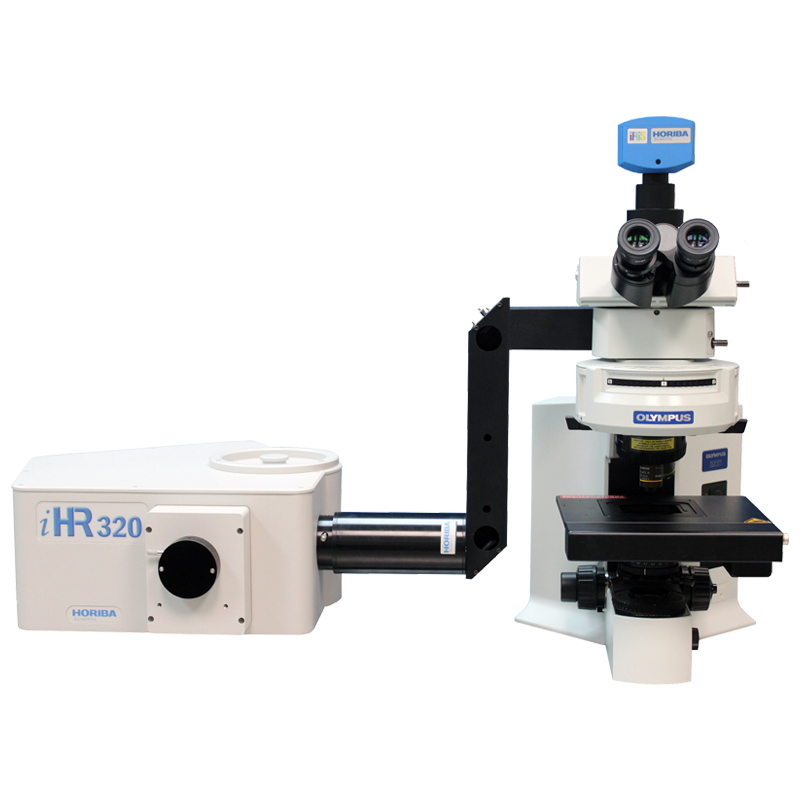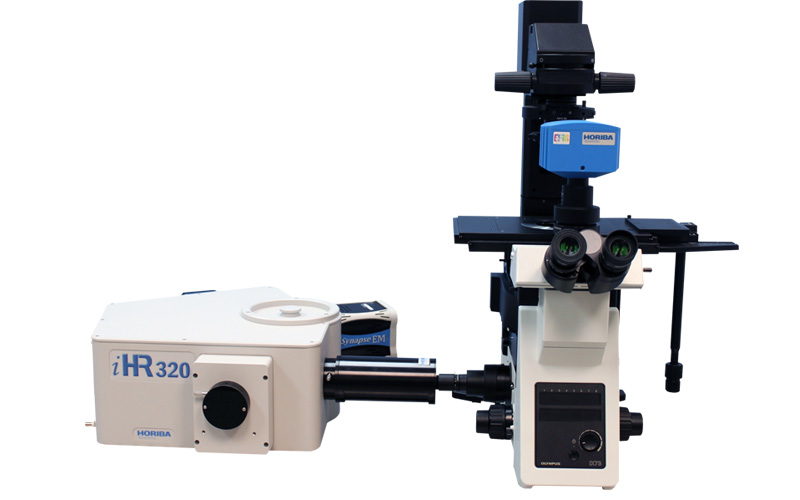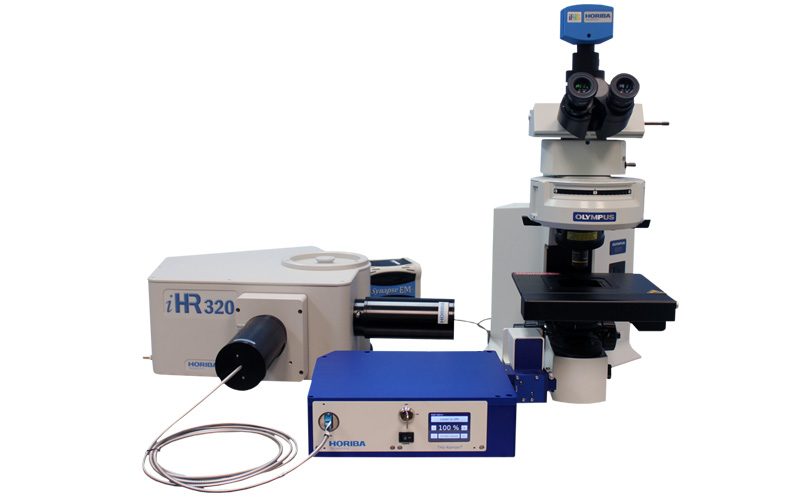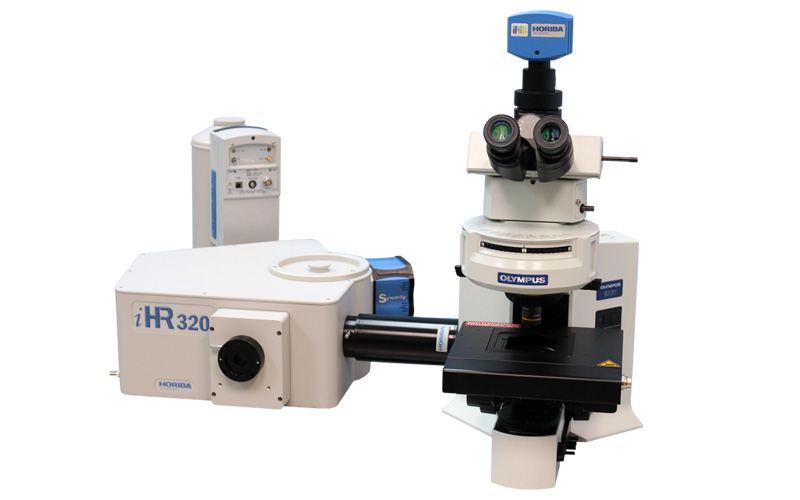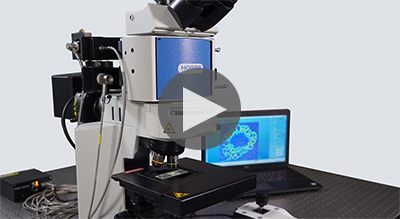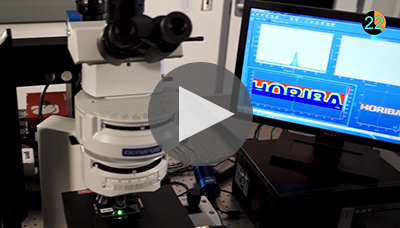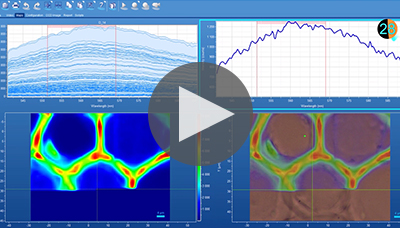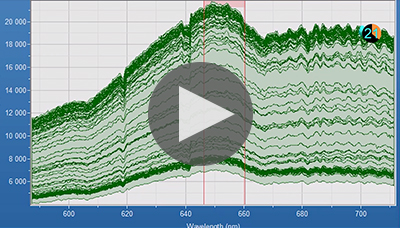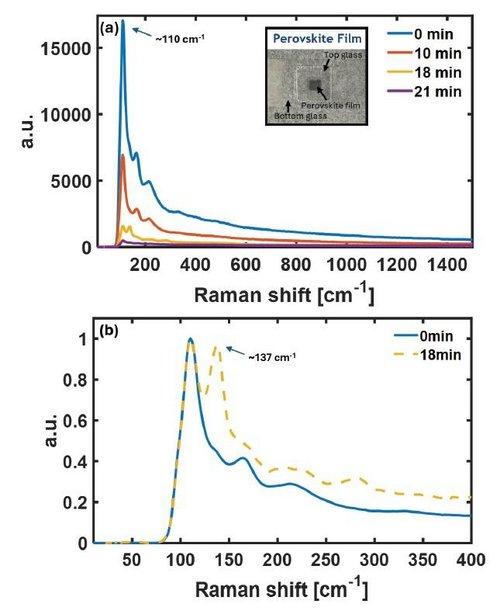
Download the SMS Brochure for more information
Raman Specifications
Spectrometer and Detectors | |||||||
Spectrometers | MicroHR | iHR320 | iHR550 | ||||
Excitation Lasers | 532 nm, 633 nm, 785 nm | ||||||
Spectral Range (cm-1) – Free space | 80 – 9500 (532 nm), 80 – 6500 (633 nm), 80 – 3400 (785 nm) | ||||||
Spectral Range (cm-1) – Fiber | 150 – 9500 (532 nm), 150 – 6500 (633 nm), 150 – 3400 (785 nm) | ||||||
Recommended Gratings | 1800 g/mm, 1200 g/mm, 600 g/mm | ||||||
Spectral Resolution1 (cm-1/ pixel) | 405 nm | 5.12 | 2.34 | 1.37 | |||
532 nm | 2.53 | 1.22 | 0.73 | ||||
633 nm | 1.54 | 0.78 | 0.48 | ||||
785 nm | 0.70 | 0.40 | 0.26 | ||||
Microscope | |||||||
Microscope Objectives | Magnification | 10X | 50X | 100X | |||
Spot Size (fiber-coupled) | < 50 μm | < 12 μm | < 6 μm | ||||
Spot Size (free space-coupled) | < 10 μm | < 5 μm | < 2 μm | ||||
Sample Stage | XYZ (Manual and motorized options available) – 75 x 50 mm; 100 x 100 mm; 150 x 150 mm; 300 x 300 mm | ||||||
Vision Camera | Software controlled vision camera included | ||||||
1 For 1800 g/mm grating and 26 μm pixel CCD
Photoluminescence Specifications
Spectrometer and Detectors | ||||||
Spectrometers | MicroHR | iHR320 | iHR550 | |||
Excitation Lasers1 | 266 nm, 325 nm, 405 nm, 532 nm, 633 nm, 785 nm, 980 nm, 1064 nm | |||||
Spectral Range (nm)2 | 250 nm – 2200 nm | |||||
Recommended Gratings3 | 1800 g/mm, 600 g/mm, 300 g/mm | |||||
Spectral Resolution4 (nm) | 0.39 | 0.18 | 0.1 | |||
Microscope | ||||||
Microscope Objectives5 | Magnification | 10X | 50X | 100X | ||
Spot Size (fiber coupled) | < 50 μm | < 12 μm | < 6 μm | |||
Spot Size (free space coupled) | < 10 μm | < 5 μm | < 2 μm | |||
Sample Stage | XYZ (Manual and motorized options available) – 75 x 50 mm; 100 x 100 mm; 150 x 150 mm; 300 x 300 mm | |||||
Vision Camera | Software controlled vision camera included | |||||
1Other laser wavelengths available on request
2 Extension into mid IR available on request
3 Other gratings available on request
4 Based on 1200 g/mm grating at 500 nm and a 26 μm pixel CCD
5 Reflective objectives may be recommended if working in the UV or using multiple sources that cover a broad spectral range
Time-resolved Photoluminescence (Lifetime) Specifications
Spectrometer and Detectors | ||||||
Spectrometers | MicroHR | iHR320 | iHR550 | |||
Excitation Lasers | Discrete pulsed sources available from 260 nm to 1060 nm | |||||
Tunable pulsed white laser from 400 nm | ||||||
Spectral Range (nm) | 250 nm – 1700 nm | |||||
Recommended Gratings1 | 1200 g/mm, 600 g/mm, 300 g/mm | |||||
Spectral Resolution2 (nm) | 0.39 | 0.18 | 0.1 | |||
Measurable Lifetime Range3 | 25 ps to seconds | |||||
Microscope | ||||||
Microscope Objectives4 | Magnification | 10X | 50X | 100X | ||
Spot Size (fiber-coupled) | < 50 μm | < 12 μm | < 6 μm | |||
Spot Size (free space-coupled) | < 10 μm | < 5 μm | < 2 μm | |||
Sample Stage | XYZ (Manual and motorized options available) – 75 x 50 mm; 100 x 100 mm; 150 x 150 mm; 300 x 300 mm | |||||
Vision Camera | Software controlled vision camera included | |||||
Additional software5 | EzTime (or EzTime Image, if doing FLIM) | |||||
1 Other gratings available on request
2 Based on 1200 g/mm grating at 500 nm and a 26 μm pixel CCD
3 Electronics and detectors for lifetimes shorter that 25 ps available on request
4 Reflective objectives may be recommended if working in the UV or using multiple sources that cover a broad spectral range
5 Both EzTime and EzTime Image can be installed on the same computer as LabSpec 6
Reflectance and Transmittance Specifications
Spectrometer and Detectors | ||||||
Spectrometers | MicroHR | iHR320 | iHR550 | |||
Excitation Sources | Xenon Lamp (200 nm – 2200 nm) | |||||
Tungsten Halogen Lamp ( > 350 nm) | ||||||
Supercontinuum Laser ( > 400 nm) | ||||||
Spectral Range (nm)1 | 250 nm – 2200 nm | |||||
Recommended Gratings2 | 1200 g/mm, 600 g/mm, 15 0 g/mm | |||||
Spectral Resolution3 (nm) | 0.39 | 0.18 | 0.1 | |||
Microscope | ||||||
Microscope Objectives4 | Magnification | 10X | 50X | 100X | ||
Spot Size (fiber-coupled) | < 50 μm | < 12 μm | < 6 μm | |||
Spot Size (free space-coupled) | < 10 μm | < 6 μm | < 2 μm | |||
Sample Stage | XYZ (Manual and motorized options available) – 75 x 50 mm; 100 x 100 mm; 150 x 150 mm; 300 x 300 mm | |||||
Vision Camera | Software controlled vision camera included | |||||
1 Extension into mid-IR available on request
2 Other gratings available on request
3 Based on 1200 g/mm grating at 500nm and a 26 μm pixel CCD
4 Reflective objectives may be recommended if working in the UV or using multiple sources that cover a broad spectral range
Electroluminescence Specifications
Spectrometer and Detectors | ||||||
Spectrometers | MicroHR | iHR320 | iHR550 | |||
Excitation Source1 | Keithley Source Meter (2400 series) | |||||
Spectral Range (nm) | 250 nm – 14 μm | |||||
Recommended Gratings2 | 1200 g/mm, 600 g/mm, 150 g/mm | |||||
Spectral Resolution3 (nm) | 0.39 | 0.18 | 0.1 | |||
Microscope | ||||||
Microscope Objectives4 | Magnification | 10X | 50X | 100X | ||
Sample Stage | XYZ (Manual and motorized options available) – 75 x 50 mm; 100 x 100 mm; 150 x 150 mm | |||||
Vision Camera | Software controlled vision camera included | |||||
1 Other current voltage sources available on request
2 Other gratings available on request
3 Based on 1200 g/mm grating at 500 nm and a 26 μm pixel CCD
4 Reflective objectives may be recommended if working in the UV, or using multiple sources that cover a broad spectral range
Photocurrent Specifications
Spectrometer and Detectors | ||||||
Spectrometers | MicroHR | iHR320 | iHR550 | |||
Excitation Sources | Lasers: 266 nm – 1064 nm | |||||
Xenon Lamp (200 nm – 2200 nm) – Tunable option available | ||||||
Tungsten Halogen Lamp ( > 350 nm) – Tunable option available | ||||||
Supercontinuum Laser ( > 400 nm) – Tunable option available | ||||||
Photocurrent Measurement1 | Keithley Source Meter (2400 series) | |||||
Recommended Gratings2 | 1200 g/mm, 600 g/mm, 150 g/mm | |||||
Spectral Resolution3 (nm) | 0.39 | 0.18 | 0.1 | |||
Microscope | ||||||
Microscope Objectives4 | Magnification | 10X | 50X | 100X | ||
Sample Stage | XYZ (Manual and motorized options available) – 75 x 50 mm; 100 x 100 mm; 150 x 150 mm; 300 x 300 mm | |||||
Vision Camera | Software controlled vision camera included | |||||
1 Extension into mid-IR available on request
2 Other gratings available on request
3 Based on 1200 g/mm grating at 500 nm and a 26 μm pixel CCD
4 Other objectives may be recommended if working in the UV, or using multiple sources that cover a broad spectral range
Darkfield Scattering Specifications
Spectrometer and Detectors | ||||||
Spectrometers | MicroHR | iHR320 | iHR550 | |||
Excitation Sources | Xenon Lamp (200 nm – 2200 nm) | |||||
Tungsten Halogen Lamp ( > 350 nm) | ||||||
Supercontinuum Laser ( > 400 nm) | ||||||
Spectral Range (nm)1 | 200 nm – 2200 nm | |||||
Recommended Gratings2 | 1200 g/mm, 600 g/mm, 150 g/mm | |||||
Spectral Resolution3 (nm) | 0.39 | 0.18 | 0.1 | |||
Microscope | ||||||
Microscope Objectives4 | Magnification | 10X | 50X | 100X | ||
Sample Stage | XYZ (Manual and motorized options available) – 75 x 50 mm; 100 x 100 mm; 150 x 150 mm; 300 x 300 mm | |||||
Vision Camera | Software controlled vision camera included | |||||
1 Extension into mid-IR available on request
2 Other gratings available on request
3 Based on 1200 g/mm grating at 500 nm and a 26 μm pixel CCD
4 Other objectives available on request
